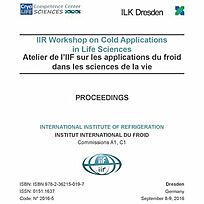
IIR document
Strategies for the design of bi-layer scaffolds for the regenerative medicine and tissue engineering.
Number: pap. 025
Author(s) : REINSCH H., KRETSCHMER R., HEIDINGSFELDER J.
Summary
In the field of regenerative medicine and tissue engineering 3-dimensional collagen scaffolds play an important role to guide the formation of functional novel tissue structures. Thereby, different cell types often have to be separated for a defined period of time to generate multilayer tissue structures like skin or to control cell migration in the process of tissue regeneration. Such applications require heterogeneous scaffold structures with a bi-layer structure. Such scaffolds can decelerate or prevent cell migration by a barrier of compacted material. Additionally they may provide different pore sizes in both of the separated scaffold areas to perfectly
suit the needs of different cell types. With the patented MBIT technology such materials can be generated in a single freeze-drying process. This novel approach can drastically reduce the production costs for 3-dimensional biomaterials with a multilayer structure because a stepwise construction of those scaffolds or a subsequent combination of two or more separately produced material layers is no longer necessary.
Available documents
Format PDF
Pages: 5 p.
Available
Public price
20 €
Member price*
Free
* Best rate depending on membership category (see the detailed benefits of individual and corporate memberships).
Details
- Original title: Strategies for the design of bi-layer scaffolds for the regenerative medicine and tissue engineering.
- Record ID : 30019514
- Languages: English
- Source: 2nd IIR Workshop on cold applications in life sciences.
- Publication date: 2016/09/08
- DOI: http://dx.doi.org/10.18462/iir.cals.2016.0025
Links
See other articles from the proceedings (25)
See the conference proceedings
Indexing
-
BIOHAZARDS ENCOUNTERED AT LOW TEMPERATURE PRESE...
- Author(s) : KLEN R.
- Date : 1987/08/24
- Languages : English
- Source: Development in refrigeration, refrigeration for development. Proceedings of the XVIIth international Congress of Refrigeration.
- Formats : PDF
View record
-
From the tissue bank to the tissue establishment.
- Author(s) : MERICKA P., STRAKOVÁ H., HORYNOVÁ A.
- Date : 2008/04/21
- Languages : English
- Source: Cryogenics 2008. Proceedings of the 10th IIR International Conference
- Formats : PDF
View record
-
Bio-inspired cryopreservation using synthetic p...
- Author(s) : BAILEY T. L., OTTEN L. C., GIBSON M. I.
- Date : 2016/09/08
- Languages : English
- Source: 2nd IIR Workshop on cold applications in life sciences.
- Formats : PDF
View record
-
PRACTICAL METHODS FOR PRESERVATION OF CULTURED ...
- Author(s) : OHNISHI K.
- Date : 1985/05/20
- Languages : English
- Source: Fundamentals and Applications of Freeze-Drying to Biological Materials, Drugs and Foodstuffs.
- Formats : PDF
View record
-
Safe reliable drug substance transfers via froz...
- Author(s) : GENTILE C., MARCINIAK M.
- Date : 2016/09/08
- Languages : English
- Source: 2nd IIR Workshop on cold applications in life sciences.
- Formats : PDF
View record
